May 2nd 2011 is going to be an important day: it is my 37th birthday, true, but that is not the point. On that day, the fashion elite will gather at the Metropolitan Museum of Art in New York to attend the annual Costume Institute Gala, which I’ve always written about. I love that this event is usually held on my birthday, because it means I can spend the day after in awe of the amazing outfits and jewellery seen on fashion insiders and celebrities in attendance. This year, the Gala will be more exciting than usual because it will open a very special exhibition, Savage Beauty, a retrospective on the incredible career of the one and only Alexander McQueen.
Nowadays, the world of fashion is like a vampire: customers and investors want more and more; two collections a year are not enough, so the presentation of new collections has become a constant flow: there’s always something new to talk about, to get excited about, new items and objects of desire to feed consumistic craves. I’m not Karl Marx and I won’t lecture on the traps of capitalism (and its by-products), but it takes no genius to understand the down-sides of the system: when the market is saturated with offers, people don’t pay attention to the artistic value of things anymore. Everything enters a whirlwind that cannot be stopped, and only carefully planned ideas and products emerge, despite their being – at times – pure commercial operations. As a consequence, the general public focuses mostly on recognizable symbols: that is the reason why McQueen, for someone, is “the one who designed skull-printed scarves”. Who cares of his unique artistry, of his genius, of the complexity of his imagery, when you can make others lust over your latest skull-printed accessory?
When I think of the magnitude of his suicide, of the void he has left as an artist, I cannot help but grieving, since I realize nobody will ever make my soul resound like his creations did. I’m no drama queen and I really mean what I’m writing: for a lover of Gothic romance and Victoriana like me, McQueen was the only one who could turn ideas, images, memories and dreams into something tangible.
I don’t think I will be able to visit the exhibition, curated by Andrew Bolton and Harold Koda, but I will surely buy the catalogue by Bolton, Tim Blanks and Susannah Frankel, graced by the amazing pictures by Sølve Sundsbø, including the ones you’ll find in this post. As a fashion nerd, I’ve decided to use the chronological order, which allows to see the evolution of his style.
This lavender corseted top is from Dante, the fall/winter 1996 collection. Masks, lace and bleached denim were featured in creations which were “not so much about death, but the awareness that it’s there”.
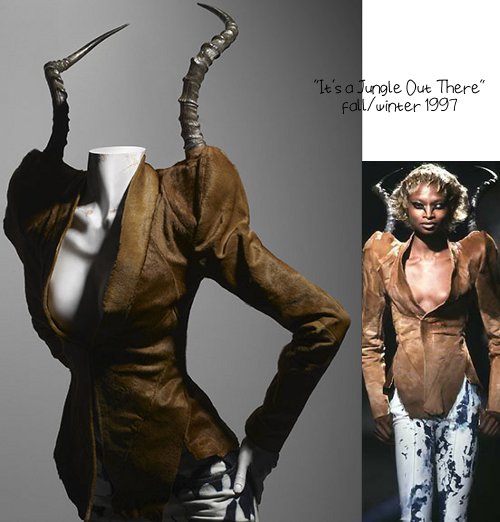
A scary pair of antelope horns coming out of shoulders of a leather fitted jacket: this piece is from It’s a Jungle Out There, the fall/winter 1997 collection, where bleached denim, religious prints and tailored clothes mixed and matched.
Joan, the fall/winter 1998 collection, was inspired by the Maid of Orléans and the massacre of the Romanov royal family inYekaterinburg in 1918. Some dresses – like the fringed one above – included full masks, while others were made of chain mail; the recurring theme of tailored clothes could be found here, too. The red lace dress Lady GaGa wore at the 2010 MTV Video Music Awards came from this collection.
McQueen’s fashion show always were daring, shocking at times, performances where clothes were just an element of the whole. One of the most original presentations – and surely one of the most exciting moments of his career – was No. 13, the spring/summer 1999 collection: the model who opened the show was Aimee Mullins, an American athlete, who walked the catwalk wearing a pair of hand-carved wooden prosthetic legs with integral boots. The model who closed it was Shalom Harlow, who wore the dress above, a unique piece of instant art.
In the pics above you can see the finale – the model standing on a rotating platform, her dress spray painted by two robots (McQueen borrowed them from the Italian car manufacturing company Fiat). This iconic moment had found its inspiration on an installation by the artist Rebecca Horn of two shotguns firing blood-red paint at each other. Is there anything more contemporary than this? Art created by a machine, the combination, as McQueen said, “of arts and crafts with technology—that weird unison between man and machine.”
Voss, the spring/summer 2001 collection, had another impressive presentation. The catwalk was inside of a glass cube, reminiscent of a mental hospital holding cell; models wore hospital headbands, thus stressing the idea they were lunatics in an asylum. Models were not alone in the glass cube, because artist Michelle Olley was leaning on a couch, naked, surrounded by living moths, breathing through a tube.
The dress above is incredible and presents one of the themes of the collection – birds and feathers.
Blood red and black feathers characterize this amazing number, which looks like a devilish ostrich. Isn’t the half-naked back incredibly sexy?
Sage chiffon and feathers are not the only notable details of this dress, which includes stuffed birds perched on head and shoulders, a Gothic version of ornitophobia, perfectly presented by Alfred Hitchcock in his masterpiece The Birds.
The fictional setting of the show was a mental hospital, so it’s not surprising McQueen gave his own rendition of a straitjacket. He made it of greyish lilac silk, all-over embroidered, and completed the outfit with a matching rectangular headpiece, embellished with ornaments resembling ivy trails or moss. This is one of the most desperately romantic items of clothing I’ve ever seen.
Irere, the spring/summer 2003 collection, was inspired to the sea (think of Elizabethan pirates) and to woods (tropical colours from the Amazon forest and creepy hints to The Blair Witch Project). The images projected during the fashion show referred exactly to these sources of inspiration – a woman falling into the sea and a mysterious girl wandering in the woods. The dress above was certainly inspired to the sea: it looks like an evening dress gone through a shipwreck – the beige tulle of the bodice is shredded, while the ruffles on the skirt remind of sea waves.
The catsuit above, on the other hand, seems to refer to something a creature of the woods could wear. The all-over embroidery on tulle turns the garment into a symbol, a graphism.
I was particularly pleased to see my favourite dress included in the exhibition. I’m sure Bolton and Koda didn’t think twice before picking this lace dress among the many designs by McQueen. How could they have left it behind?
The Widows of Culloden, the fall/winter 2006 collection, was shown on a wood stage with a central glass pyramid (a breath-taking hologram of Kate Moss, a piece by the video maker Baillie Walsh, appeared in it at the end of the show). The collection was a homage to McQueen’s Scottish descent and inspired to an historical event (the Battle of Culloden, which took place in April 1746, when the Jacobite forces of Charles Edward Stuart faced an army commanded by William Augustus, Duke of Cumberland, loyal to the British government). This was not the first time McQueen paid homage to his ancestors (think of the much debated fall/winter 1995 collection, Highland Rape), but here history was infused with Victorian and Shakespearean fantasies.
Tulle ruffles characterize this dress, reminiscent of a trail of white smoke.
Sarabande, the spring/summer 2007 collection, was inspired to Stanley Kubrick’s Barry Lyndon and its key music theme (Georg Friedrich Handel’s Sarabande, from suite No. 11), to the paintings of Francisco Goya, the eccentric style of Marchesa Casati and Edwardian fashion. The romantic vibe was tinged with melancholia and a sense of decay: the dress above, for example, was made of real flowers because, according to the designer, they were destined to rot and die.
An exaggerated hourglass shape is featured in this dusty pink jacket, with flowers blooming in the neckline and sleeves; it is paired to a crinoline skirt with padded hips.
The Girl Who Lived in the Tree, the fall/winter 2008 collection, is definitely one of my favourite collections ever. The fashion show took place on a stage draped with white fabric, a big wrapped tree at the centre. The tree was the symbol of the collection itself, inspired, according to the designer, to a 600-year-old elm tree in his garden; he imagined a girl lived on that tree, who would come down at night to meet a prince and thus become a queen. Echoes from the British Empire (India, in particular) and to Victorian fashion were present, as well. Alyona Osmanova wore the last outfit of the show, an impressive China red taffeta coat, which easily became the most photographed item of the collection.
The Horn of Plenty was a highly dramatic collection, designed for the fall/winter 2009, a homage to his past as a fashion creator but also a harsh criticism to a collapsed economy (see the heap of industrial trash at the centre of the catwalk).The main theme of the spring/summer 2009 collection, Natural Dis-tinction, Un-natural Selection (climate change, globalization and industrialization), was given a harsh and dark spin here, as shown by the black feathered dress above, with exaggerated hips and shoulders.
Scraps from industrialization – a black plastic-looking fabric – were used to make this dress, which had an asymmetrical hem, ruffled skirt and buckled bodice.
Plato’s Atlantis, the spring/summer 2010 collection, was live-streamed on Nick Knight’s SHOWstudio.com and introduced by a video of Raquel Zimmermann lying on the sand, snakes crawling on her body (the advertising campaign of that season had the same concept). Lady GaGa’s Bad Romance closed the fashion show, so it’s not coincidental that the singer wore the dress above in the video of her single. The theme of the collection was, again, the future ecological meltdown of the world.
The last, untitled collection (fall/winter 2010) was privately shown in a salon at the headquarters of François Pinault. When McQueen committed suicide, in February 2010, 80% of the collection was finished. Leaving technology behind, he had gone back to his love for tailoring and craftsmanship: an aura of romanticism pervades the 16 outfits of the collection, extensively inspired to Byzantine, Medieval and Reinassance art. References to his early works were present, as well: the banded heads of the models and the jacket above, fully covered with golden feathers, for example, remind of his Voss collection.
Silk printed with a painting and architectural decorative motifs and a touch of gold yellow feathers can be found in this one-shoulder dress.
Light-feather printed silk makes this long dress amazing: the flowy full skirt can be fully appreciated above, in the shot by Sundsbø.
Sarah Burton, currently creative director of the maison, worked with McQueen for 14 years: she surely is the best option to replace the designer and she’s actually doing a great job (the fall/winter 2011 collection, with its “Ice Queen” theme was brilliant), but obviously she’s not him. If I think his designs and elaborate fashion shows will never grace our lives, my heart wrings a bit and the world appears as it is, shallow and complicated most of the time, with very few cultural sun-rays to light it up. You will be really missed, Lee.


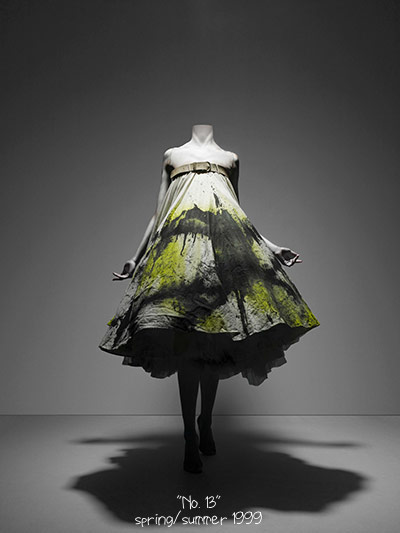

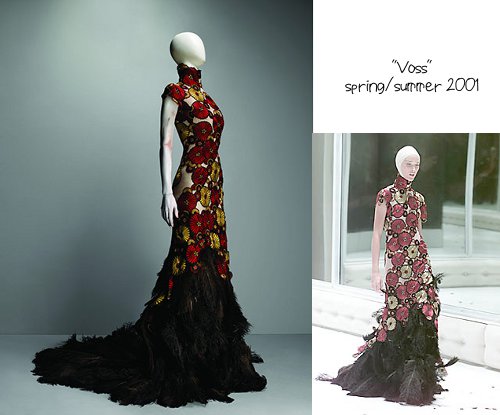
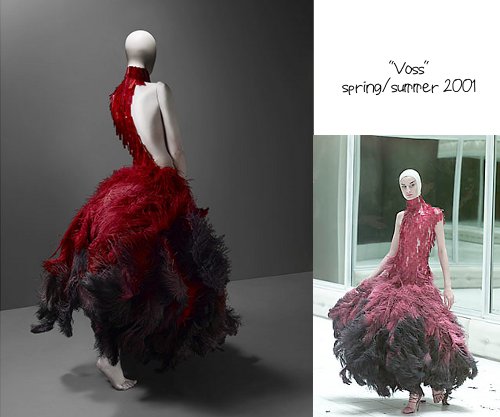


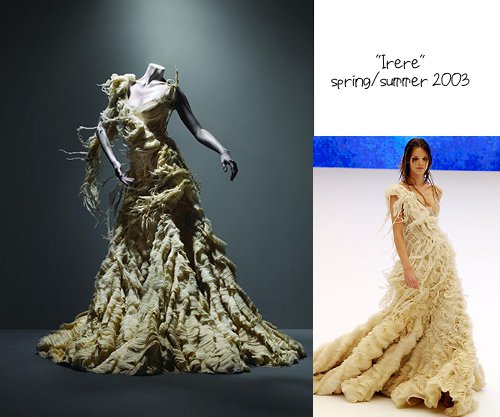





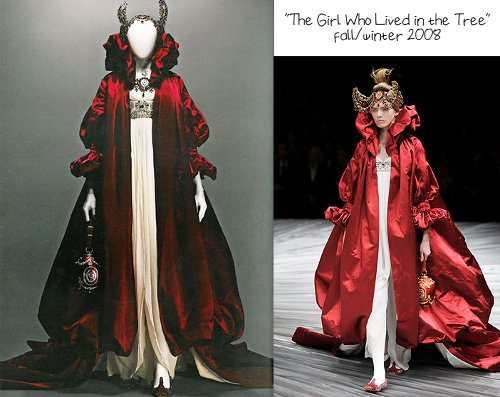
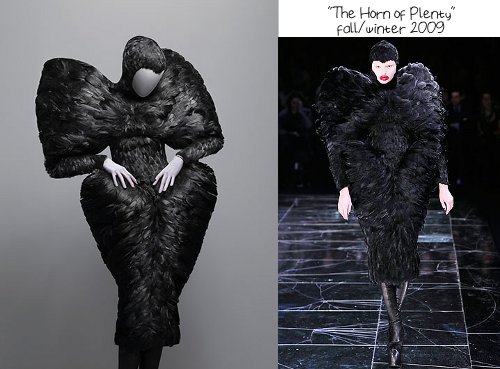
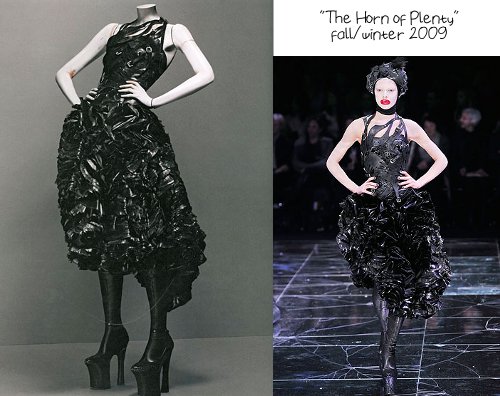




Thank you for this beautiful piece of writing, which once again reminds me of McQueen’s genius. I have always loved the way he managed to embody so much of the English/ British spirit and tradition in his work. My favourite collection is “The Girl Who Lived in the Tree”, because in my opinion it is imbued in Orientalism and nostalgia for the Empire, and I think it can say a lot even about contemporary England. He will be truly missed.
And yet, to think that McQueen’s talent can be dismissed by some ignorants (because this is what they are) as “the guy who does the skull scarves” (probably this pearl of wisdom is courtesy of a certain fashion blogger) saddens me even more than the thought that we will never see a collection like the ones he used to design.
I know: the trivialization of what he did is extremely saddening but, alas, it’s also a sign of the times. I don’t know if this happens elsewhere or if it’s only a sign of the unstoppable decay of Italian society.
Yet, I always think focusing on the sunny side of things is much more rewarding than paying attention to ignorants. For this reason, I still cannot fully realize he’s gone forever: his creations and fashion shows will be remembered but these times would haven’t been so dark with him.
This is such a beautiful piece, your writing really captivated me and drew me in to the article and the pictures were a great way to finish it off for me. I miss McQueen so much, his designs were so inspirational, and as you said, I too feel like the fashion industry has been left with a gaping void due to his suicide. They say suicide is the most selfish act one can commit, and although the nature of his death affects us no more than in what we find beautiful to look at, beauty is an important thing. McQueens creations were genious and hopefully, one day, someone will carry the legacy he left. I miss intricate feathering and masked outrageous designs. To me, he has always been more about art and less about fashion.
Please check out my blog if you have time 🙂
Grazie per questo post che mi ha fatto sognare ed emozionare come non mi succedeva da tempo. =)
Che gentile! Grazie mille 🙂
Amazing piece of retrospective! I love McQueen and this post made me appreciate him even more. 🙂
Thanks! I’m glad you’ve appreciated it.
I’ve been a McQueen supporter for many years but I couldn’t remember how much genius there was in his earlier collections. Doing some research before writing this post made me realize he was an artist true to himself and to his vision, who never compromised. I find that his “integralism” definitely was a sign of his genius.